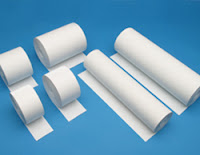Shelf Life - Storage of thermal products in a dark place at a
relative humidity between 45 percent and 65 percent and a temperature below
77°F (25ºC) will assure satisfactory performance for at least three years from
the date of manufacture.
Image
Life -
Once thermal paper has been imaged on the recommended equipment, it is expected
that the image will remain legible for at least seven years, assuming the
documents are properly stored with compatible materials under normal filing
conditions, with a relative humidity between 45 percent and 65 percent, as well
as a temperature below 77°F (25°C).
Fade
Resistance -
Most thermal products use dye and co-reactant technology to form an
image. The combination is sensitive to ultraviolet (UV) light and may exhibit
some image decline with extended exposure to office light or shorter exposure
to intense UV light (sunlight). The stability of the image will depend upon the
degree to which the image was originally developed, the individual product
design, the intensity of the UV light and the character of UV (percent of UV
range in a light source). Sheet discoloration may also occur with prolonged
exposure to UV light.
Contact
Storage -
We recommend that thermal grades not be exposed for long periods to the
following specific materials to avoid:
1.
Organic solvents, including: Alcohol, Ketones, Esters, Ethers,
2.
Cleaning fluids3. Plasticizers: Alcohol-type (cellophane tape), Ester-type (PVC film), Polyethylene glycol-type Dioctyl phthalate, Dioctyl adipate
4. Petroleum solvents: Gasoline, Toluene and Benzene
5. Wet-type diazo copy paper
6. Carbon papers (certain types)
7. Cast-coated papers
8. Papers containing tributyl phosphate
9. Dissimilar thermal systems
10. Carbonless paper solvents
11. Ammonia
12. Certain oils
13. Water (prolonged exposure)
An exception to these general guidelines would be our specialty top-coated media, tag, ticket and label grades.
Note: Most thermal
papers, regardless of the manufacturer, are susceptible to many of the same
items shown on this page. These incompatible substances are not unique to any
thermal products.
Please
feel free call us if you have any questions on thermal paper storage and shelf life
recommendations.


















